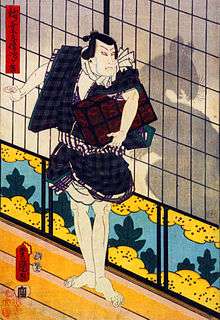Nezumi Kozō
Nezumi Kozō (鼠小僧) is the nickname of Nakamura Jirokichi (仲村次郎吉, 1797–1831), a Japanese thief and folk hero who lived in Edo (present-day Tokyo) during the Edo period.[1]

New Year day, 4th year of Ansei (February, 1857) at the first play at Yedo Ichimura-za, Nezumi komon haruno shingata (鼠小紋東君新形), drawn by Utagawa Toyokuni II[lower-alpha 1]
His exploits have been commemorated in kabuki theatre, folk songs, jidaigeki, and modern pop culture.
Capture and tattoo
In 1822, he was caught and tattooed, and banished from Edo. On August 8, 1831, he was captured again, and confessed to the burglary of over 100 samurai estates and the impressive theft of over 30,000 ryō throughout his 15-year career. He was tied to a horse and paraded in public before being beheaded at the Suzugamori execution grounds. His head was then publicly displayed on a stake. He was buried at Ekō-in located in the Ryōgoku section of Tokyo. So many pilgrims chip away pieces of his tombstone for charms that his headstone has had to be replaced a number of times since shortly after his death.[1]
Background
At the time of the arrest, Jirokichi was found to have very little money. This, combined with the public humiliation he dealt out to the daimyō, resulted in the popular legend that he gave the money to the poor, turning the petty crook into a posthumous folk hero similar to Robin Hood. The fact that he died alone, serving his wives with divorce papers just prior to arrest in order to protect them from sharing in the punishment as the law decreed, further enhanced his stature.
Nickname
Jirokichi's nickname Nezumi Kozō roughly means "Rat Kid".[2]
The word nezumi means "rat"' or "mouse" and kozō translates to "kid, brat".[3] The term kozō is a somewhat pejorative word for any young male.[lower-alpha 2][4]
As pickpocket were often young boys and girls since the profession required nimble fingers, it has been suggested that Jirokichi was a well known pickpocket when he was younger. In actuality, even though the nickname containing the term kozō was frequently applied to pickpockets, there are many other instances where it became the epithet of other types of criminals.[lower-alpha 3][5]
Media
- Nezumi, Edo wo hashiru : a Japanese television series relating the adventures of Nezumi Kozo, with Hideaki Takizawa in the main part.
- In the game Persona 5, there is a pop quiz question related to his execution.
Explanatory notes
- There are four Utagawa Toyokunis and this "Utagawa Toyokuni II" can not be decided without citation as the III called himself the II.
- A kozō can also mean 1. a young apprentice at a Buddhist temple, or 2. an errand-boy at a shop
- Shigematsu names Inaka Kozō、Inaba Kozō、Ichimatsu Kozō (市松小僧)、Aoi Kozō、and Nezumi Kozō who were burglars.
References
- Citations
- Goodman, David G. (1986). Pg 256-257. "After Apocalypse: Four Japanese Plays of Hiroshima and Nagasaki", New York: Columbia University Press.
- "Ume no haru gojūsan tsugi" (梅初春五十三驛) (performed 2007), National Theatre of Japan: Kabuki Performance 253, p. 65 (programming guide, English text). Cf. online information in Japanese via Japan Arts Council
- "kozō (3) in Kenkyusha's College English-Japanese Dictionary (Chujiten, 6th ed., 1994).
- "kozō (3) in Kojien (4th ed., 1991).
- Shigematsu (1986), p. 142.
- Bibliography
- Shigematsu, Kazuyoshi (1986). Edo no hanzai hakusho 江戸の犯罪白書. PHP Kenkyusho.CS1 maint: ref=harv (link)